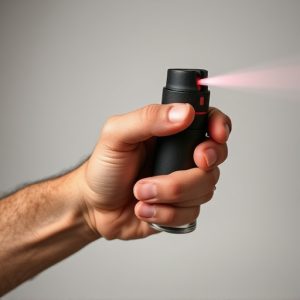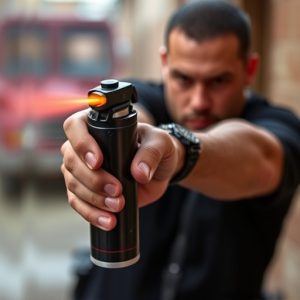Mastering Personal Safety: Treating & Preventing Pepper Spray Exposure
Pepper spray exposure requires immediate action. Move to fresh air, remove contaminated clothing, an…….
Pepper spray exposure requires immediate action. Move to fresh air, remove contaminated clothing, and flush eyes with water for 15 minutes. For minor symptoms, over-the-counter relief may help; severe cases need medical attention. Understanding local laws regarding pepper spray is crucial for safe handling and responsible use as a self-defense tool. Prompt treatment and knowledge of how to manage exposure are vital for personal safety against potential harm from pepper spray attacks.
Personal safety is a paramount concern in today’s unpredictable world. One potent tool often discussed for self-defense is inflammatory pepper spray. This article delves into the intricacies of this chemical agent, covering its composition and effects, crucial knowledge for understanding its power. We also outline immediate steps to take after exposure, medical treatment options for injuries, legal considerations, and most importantly, effective strategies to prevent attacks. Learn how to treat pepper spray exposure and equip yourself with vital self-defense knowledge.
- Understanding Pepper Spray: Its Composition and Effects
- Immediate Steps After Pepper Spray Exposure
- Medical Treatment and Care for Pepper Spray Injuries
- Legal Considerations and Rights When Using Pepper Spray
- Preventing Pepper Spray Attacks: Safety Measures and Strategies
Understanding Pepper Spray: Its Composition and Effects
Pepper spray, a powerful tool for personal safety, is designed to incapacitate and disorient an attacker, providing a crucial window of opportunity for escape. Its active ingredient is capsaicin, a natural compound found in chili peppers, which irritates the eyes, nose, and respiratory system when inhaled or in contact with skin. This irritation leads to temporary blindness, coughing, and difficulty breathing, allowing the user to flee or seek help.
Understanding how pepper spray works is essential for knowing how to treat exposure. If exposed, the first step is to move to an area with fresh air immediately. Removing any contaminated clothing and washing the affected areas with soap and water can help dilute the capsaicin. For eye contact, flushing with clean water for at least 15 minutes is recommended. Seeking medical attention is crucial if symptoms persist or severe reactions occur, as pepper spray exposure can be uncomfortable and potentially dangerous, especially for individuals with pre-existing respiratory conditions.
Immediate Steps After Pepper Spray Exposure
If you’ve been exposed to pepper spray, it’s crucial to take immediate action to mitigate the effects. The first step is to get to a safe, open area away from the source of the spray. Remove any clothing or items that may have absorbed the spray, such as eye glasses or hair, as these can continue to expose you. Rinse your face and eyes thoroughly with water for at least 15 minutes; this will help flush out the irritants.
Next, seek fresh air immediately. If possible, move to a place where you can breathe deeply and comfortably. Avoid rubbing your eyes or face, as this can worsen irritation. You can apply a cold compress to affected areas like the eyes, nose, and cheeks to provide some relief from swelling and stinging. Remember, how to treat pepper spray exposure involves these swift actions to ensure your comfort and safety while waiting for the effects to subside.
Medical Treatment and Care for Pepper Spray Injuries
Pepper spray injuries can range from mild irritation to more severe reactions, and proper medical treatment is essential for healing and preventing complications. If exposed to pepper spray, it’s crucial to immediately seek fresh air by moving to an open area or turning on ventilation systems. Remove any contaminated clothing, washing eyes and face with plenty of water for at least 15 minutes to dilute the irritant.
For minor symptoms like stinging, tearing, or redness, over-the-counter antihistamines and eye drops can provide relief. In more severe cases, especially if breathing is affected, seek immediate medical attention. A healthcare provider may recommend further treatments such as corticosteroids, topical creams, or specialized eye washes depending on the severity of exposure and individual health considerations. How to treat pepper spray exposure varies, so understanding these steps can help ensure prompt and effective care.
Legal Considerations and Rights When Using Pepper Spray
When considering personal safety and carrying pepper spray, it’s crucial to understand the legal implications in your region. The use of pepper spray is regulated by local laws, which vary significantly from one place to another. Some areas allow its possession for self-defense purposes, while others may restrict its use to law enforcement only. Before purchasing and carrying pepper spray, familiarize yourself with the specific laws in your area to avoid legal repercussions.
Knowing how to handle and store it safely is also essential, especially when considering its potential impact on both the user and bystanders. In case of accidental exposure or misuse, understanding how to treat pepper spray exposure is vital. This includes knowing immediate de-escalation techniques, such as removing contaminated clothing, flushing eyes with water for at least 15 minutes, and seeking medical attention if necessary. Staying informed about these considerations ensures the responsible use of pepper spray for personal safety.
Preventing Pepper Spray Attacks: Safety Measures and Strategies
Preventing Pepper spray attacks is a crucial aspect of personal safety, especially in today’s unpredictable world. Here are some effective measures and strategies to ward off potential threats and learn how to treat pepper spray exposure if needed.
Firstly, staying aware of your surroundings is vital. Keep an eye out for suspicious activities or individuals, and trust your instincts if something feels amiss. Secondly, carry a personal safety device like inflammatory pepper spray with you at all times. Ensure it’s easily accessible, and familiarize yourself with its usage. In case of an attack, aim for the attacker’s eyes, nose, and mouth to neutralize them temporarily. After use, quickly move to a safe location to allow the spray to wear off before washing the affected area with warm water and mild soap to prevent skin irritation or eye damage, knowing how to treat pepper spray exposure is an invaluable skill for self-defense.
Understanding how to handle pepper spray exposure is crucial for personal safety. By knowing its composition, immediate steps to take after contact, and medical treatment options, individuals can mitigate the effects of such an attack. Additionally, legal considerations and preventive strategies are essential tools in safeguarding against pepper spray misuse. Equip yourself with this knowledge to ensure you’re prepared and aware, making it a game-changer in protecting your well-being. Remember, knowing How to Treat Pepper Spray Exposure could be the key to avoiding long-term health issues and ensuring your rights remain protected.


